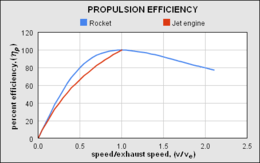Reaction engine
A reaction engine is an engine or motor that produces thrust by expelling reaction mass, in accordance with Newton's third law of motion. This law of motion is most commonly paraphrased as: "For every action force there is an equal, but opposite, reaction force."
Examples include jet engines, rocket engines, pump-jet, and more uncommon variations such as Hall effect thrusters, ion drives, mass drivers, and nuclear pulse propulsion.
Energy use
Propulsive efficiency
For all reaction engines that carry on-board propellant (such as rocket engines and electric propulsion drives) some energy must go into accelerating the reaction mass. Every engine wastes some energy, but even assuming 100% efficiency, the engine needs energy amounting to
(where M is the mass of propellent expended and is the exhaust velocity), which is simply the energy to accelerate the exhaust.

Comparing the rocket equation (which shows how much energy ends up in the final vehicle) and the above equation (which shows the total energy required) shows that even with 100% engine efficiency, certainly not all energy supplied ends up in the vehicle – some of it, indeed usually most of it, ends up as kinetic energy of the exhaust.
If the specific impulse () is fixed, for a mission delta-v, there is a particular that minimises the overall energy used by the rocket. This comes to an exhaust velocity of about ⅔ of the mission delta-v (see the energy computed from the rocket equation). Drives with a specific impulse that is both high and fixed such as Ion thrusters have exhaust velocities that can be enormously higher than this ideal, and thus end up powersource limited and give very low thrust. Where the vehicle performance is power limited, e.g. if solar power or nuclear power is used, then in the case of a large the maximum acceleration is inversely proportional to it. Hence the time to reach a required delta-v is proportional to . Thus the latter should not be too large.
On the other hand, if the exhaust velocity can be made to vary so that at each instant it is equal and opposite to the vehicle velocity then the absolute minimum energy usage is achieved. When this is achieved, the exhaust stops in space ^ and has no kinetic energy; and the propulsive efficiency is 100% all the energy ends up in the vehicle (in principle such a drive would be 100% efficient, in practice there would be thermal losses from within the drive system and residual heat in the exhaust). However, in most cases this uses an impractical quantity of propellant, but is a useful theoretical consideration.
Some drives (such as VASIMR or electrodeless plasma thruster) actually can significantly vary their exhaust velocity. This can help reduce propellant usage and improve acceleration at different stages of the flight. However the best energetic performance and acceleration is still obtained when the exhaust velocity is close to the vehicle speed. Proposed ion and plasma drives usually have exhaust velocities enormously higher than that ideal (in the case of VASIMR the lowest quoted speed is around 15 km/s compared to a mission delta-v from high Earth orbit to Mars of about 4 km/s).
For a mission, for example, when launching from or landing on a planet, the effects of gravitational attraction and any atmospheric drag must be overcome by using fuel. It is typical to combine the effects of these and other effects into an effective mission delta-v. For example, a launch mission to low Earth orbit requires about 9.3–10 km/s delta-v. These mission delta-vs are typically numerically integrated on a computer.
Cycle efficiency
All reaction engines lose some energy, mostly as heat.
Different reaction engines have different efficiencies and losses. For example, rocket engines can be up to 60–70% energy efficient in terms of accelerating the propellant. The rest is lost as heat and thermal radiation, primarily in the exhaust.
Oberth effect
Reaction engines are more energy efficient when they emit their reaction mass when the vehicle is travelling at high speed.
This is because the useful mechanical energy generated is simply force times distance, and when a thrust force is generated while the vehicle moves, then:
where F is the force and d is the distance moved.
Dividing by length of time of motion we get:
Hence:
where P is the useful power and v is the speed.
Hence, v should be as high as possible, and a stationary engine does no useful work.[NB 1]
Types of reaction engines
- Rocket-like
- Airbreathing
- Liquid
- Rotary
- Solid exhaust
See also
- Internal combustion engine
- Jet force
- Jet propulsion
- List of plasma physics articles
- Thruster (disambiguation)
Notes
- Note, that might seem to suggest that a stationary engine would not start to move. However, at low speeds the amount of energy needed to start to move tends to zero faster than the power does. So in practice it does move, as you would expect.